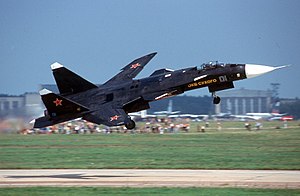Su-47 Berkut
| Su-47 Berkut | |
|---|---|
 |
|
| Role | Experimental/Technology demonstrator |
| Manufacturer | Sukhoi |
| First flight | 25 September 1997 |
| Status | Cancelled |
| Primary user | Russian Air Force |
| Number built | 1 |
The Sukhoi Su-47 Berkut (Russian: Сухой Су-47 Беркут—Golden Eagle) (NATO reporting name Firkin), also designated S-32 and S-37 (not to be confused with the twin-engined delta canard design offered by Sukhoi in the early 1990s under the designation Su-37) during initial development, was an experimental supersonic jet fighter developed by Sukhoi Aviation Corporation. A distinguishing feature of the aircraft was its forward-swept wing that gave the aircraft excellent agility and maneuverability. While serial production of the type never materialized, the sole aircraft produced served as a technology demonstrator prototype for a number of advanced technologies later used in the 4.5 generation fighter SU-35BM and current fifth-generation jet fighter prototype Sukhoi PAK FA T-50.
On 11 August 2014, Commander-in-chief of the Russian Air Forces, Colonel General Viktor Bondarev claimed that Russia is still continuing the research and development of Su-47 or similar forward-swept wing fighters. The new prototypes of such aircraft will be unveiled in the near future.
Originally known as the S-37, Sukhoi redesignated its advanced test aircraft as the Su-47 in 2002. Officially nicknamed Berkut (Golden Eagle), the Su-47 was originally built as Russia's principal testbed for composite materials and sophisticated fly-by-wire control systems.
TsAGI has long been aware of the advantages of forward-swept wings, with research including the development of the Tsibin LL and study of the captured Junkers Ju 287 in the 1940s. At high angles of attack, the wing tips remain unstalled allowing the aircraft to retain aileron control. Conversely to more conventional rear-swept wings, forward sweep geometrically creates increased angle of incidence of the outer wing sections when the wing bends under load. The wings experience higher bending moments, leading to a tendency for the wings to fail structurally at lower speeds than for a straight or aft-swept wing.
...
Wikipedia
